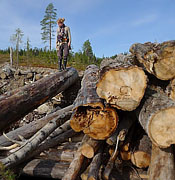Press release 2012-10-11 at 10:00
|
|

|
|
Photo by Olli Manninen
|
Maksimjärvensalo, situated south of the Kostamus Strict Nature Reserve, is a wilderness area unaffected by loggings, thus, being an important part of the Green Belt of Fennoscandia. A proposal has been made to protect it as part of the GAP analysis development project of the protected area network in Northwest Russia. Many observations of polypores, lichens and bryophytes threatened in Finland have been made in the area. Some of these species are classified as threatened in Karelia, as well. The continuous forested wilderness area also provides an important habitat for the forest reindeer (Rangifer tarandus fennicus) whose populations have declined rapidly in Karelia. More information is needed on the area’s natural values to ensure that the valuable forest environment, which has remained in its natural state, will not be lost due to loggings.
Due to hard accessibility of the Maksimjärvensalo wilderness area, detailed information on its natural values has not previously been available. During a Finnish-Russian project coordinated by the Finnish Environment Institute, inventories and studies were carried out in cooperation with the Karelian Research Centre of the Russian Academy of Sciences and the Directorate of Regional Protected Areas of the Republic of Karelia. In addition to the Finnish Environment Institute, representatives of the Kostamus State Nature Reserve, the Karelian Research Centre and the Directorate of Regional Protected Areas of the Republic of Karelia, as well as people carrying out inventories from Finland and Sweden participated in the work.
According to the preliminary inventories, a large proportion of the area’s forests is completely in a natural state or shaped by the slash and burn culture. The oldest pine generation in the forests is as old as 400–500 years, and even the slash and burn culture has not broken the forests’ historic continuity. The extensive and continuous old-growth forests include many stands in development stages following natural forest fires, and many spruce mires around larger mire areas, which are seldom found in their natural state in Finland’s neighbouring areas.
A large share of the area has been excluded from logging operations through a moratorium agreement made between Russian non-governmental nature conservation organisations and forest industry companies. However, the agreement was partly dismantled a few years ago, and roads have been constructed and extensive logging operations launched in the areas south and north of Lake Maksimjärvi.
More detailed information on the area is needed to reconcile the area’s conservation needs and pressures from other forms of use. The plan is to continue studies next summer to ensure that invaluable forests will not be lost due to fellings.
Further information
Raimo Heikkilä, Leading Researcher, Finnish Environment Institute,
tel. + 358 50 352 0888, firstname.lastname@environment.fi
Tapio Lindholm, Leading Expert, Finnish Environment Institute,
tel. + 358 40 740 1598, firstname.lastname@environment.fi
Olli Manninen, Forest Inventory Specialist, Finnish Nature League,
tel. + 358 50 594 0429, firstname.lastname@environment.fi
Photos for media
Dead pines and aspens damaged by decay at the side of a forest access road north of Lake Maksimjärvi. (.jpg, 484 kt. Photo by Olli Manninen)
A forest pond in Maksimjärvensalo. Behind the pond, there is an old-growth forest completely in its natural state. (.jpg, 579 kt. Photo by Olli Manninen)
Hundreds of years old pines with a thick bark comprised of large shield-like formations are typical in Maksimjärvensalo. (.jpg, 591 kt. Photo by Olli Manninen)
Scars left by a forest fire are visible on old pine trees. A new generation of pines emerges from the burnt forest floor.
(.jpg, 561 kt. Photo by Olli Manninen)